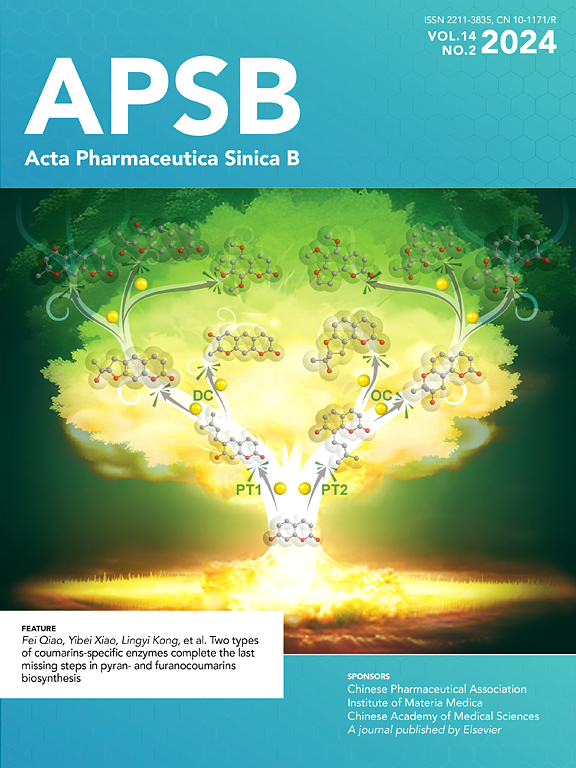Self-degradable “gemini-like” ionizable lipid-mediated delivery of siRNA for subcellular-specific gene therapy of hepatic diseases
IF 14.7
1区 医学
Q1 PHARMACOLOGY & PHARMACY
引用次数: 0
Abstract
Tailored lipid nanoparticles (LNPs)-mediated small interfering RNA (siRNA) nanomedicines show promise in treating liver disease, such as acute liver injury (ALI) and non-alcoholic steatohepatitis (NASH). However, constructing LNPs that address biosafety concerns, ensure efficient delivery, and target specific hepatic subcellular fractions has been challenging. To evade above obstacles, we develop three novel self-degradable “gemini-like” ionizable lipids (SS-MA, SS-DC, SS-MH) by incorporating disulfide bonds and modifying the length of ester bond and tertiary amino head. Our findings reveal that the disulfide-bond-bridged LNPs exhibit reduction-responsive drug release, improving both biosafety and siRNA delivery efficiency. Furthermore, the distance of ester bond and tertiary amino head significantly influences the LNPs’ pKa, thereby affecting endosomal escape, hemolytic efficiency, absorption capacity of ApoE, uptake efficiency of hepatocytes and liver accumulation. We also develop the modified-mannose LNPs (M-LNP) to target liver macrophages specifically. The optimized M-MH_LNP@TNFα exhibits potential in preventing ALI by decreasing tumor necrosis factor α (TNFα) levels in the macrophages, while MH_LNP@DGAT2 could treat NASH by selectively degrading diacylglycerol O-acyltransferase 2 (DGAT2) in the hepatocytes. Our findings provide new insights into developing novel highly effective and low-toxic “gemini-like” ionizable lipids for constructing LNPs, potentially achieving more effective treatment for hepatic diseases.

自降解的“双子星样”可电离脂质介导siRNA递送用于肝脏疾病的亚细胞特异性基因治疗
量身定制的脂质纳米颗粒(LNPs)介导的小干扰RNA (siRNA)纳米药物在治疗肝脏疾病,如急性肝损伤(ALI)和非酒精性脂肪性肝炎(NASH)方面显示出前景。然而,构建能够解决生物安全问题、确保高效递送和靶向特定肝脏亚细胞组分的LNPs一直具有挑战性。为了避免上述障碍,我们通过加入二硫键和修改酯键和叔氨基头的长度,开发了三种新型自降解的“双子型”可电离脂质(SS-MA, SS-DC, SS-MH)。我们的研究结果表明,二硫化物键桥接LNPs具有还原反应性药物释放,提高了生物安全性和siRNA递送效率。此外,酯键和叔氨基头的距离显著影响LNPs的pKa,从而影响内体逃逸、溶血效率、ApoE的吸收能力、肝细胞摄取效率和肝脏蓄积。我们还开发了特异性靶向肝巨噬细胞的修饰甘露糖lnp (M-LNP)。优化后的M-MH_LNP@TNFα通过降低巨噬细胞中的肿瘤坏死因子α (TNFα)水平显示出预防ALI的潜力,而MH_LNP@DGAT2可以通过选择性降解肝细胞中的二酰基甘油o -酰基转移酶2 (DGAT2)来治疗NASH。我们的发现为开发用于构建LNPs的新型高效低毒“双子星样”可电离脂质提供了新的见解,可能实现更有效的肝脏疾病治疗。
本文章由计算机程序翻译,如有差异,请以英文原文为准。
求助全文
约1分钟内获得全文
求助全文
来源期刊

Acta Pharmaceutica Sinica. B
Pharmacology, Toxicology and Pharmaceutics-General Pharmacology, Toxicology and Pharmaceutics
CiteScore
22.40
自引率
5.50%
发文量
1051
审稿时长
19 weeks
期刊介绍:
The Journal of the Institute of Materia Medica, Chinese Academy of Medical Sciences, and the Chinese Pharmaceutical Association oversees the peer review process for Acta Pharmaceutica Sinica. B (APSB).
Published monthly in English, APSB is dedicated to disseminating significant original research articles, rapid communications, and high-quality reviews that highlight recent advances across various pharmaceutical sciences domains. These encompass pharmacology, pharmaceutics, medicinal chemistry, natural products, pharmacognosy, pharmaceutical analysis, and pharmacokinetics.
A part of the Acta Pharmaceutica Sinica series, established in 1953 and indexed in prominent databases like Chemical Abstracts, Index Medicus, SciFinder Scholar, Biological Abstracts, International Pharmaceutical Abstracts, Cambridge Scientific Abstracts, and Current Bibliography on Science and Technology, APSB is sponsored by the Institute of Materia Medica, Chinese Academy of Medical Sciences, and the Chinese Pharmaceutical Association. Its production and hosting are facilitated by Elsevier B.V. This collaborative effort ensures APSB's commitment to delivering valuable contributions to the pharmaceutical sciences community.
 求助内容:
求助内容: 应助结果提醒方式:
应助结果提醒方式:


